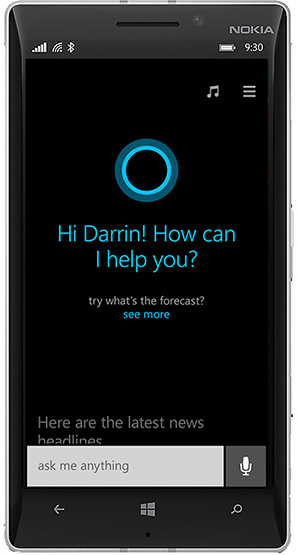Say Hello to Microsoft’s Answer to Siri
A virtual assistant that understands voice commands and learns about its owner is at the heart of a new version of Microsoft’s mobile operating system, announced today at the company’s annual conference for software developers in San Francisco.

Like Siri for iOS devices and Google Now for Android phones, Cortana can answer spoken questions like “How old is Barack Obama”; and it can act on commands such as “Wake me up at 7 a.m. tomorrow.” However, in a demonstration of the app given at Microsoft’s Build conference, Cortana appeared to be more closely integrated with other functions and apps on a device than its competitors. Unlike Siri and Google Now, it is possible for developers to write apps that can be controlled using Cortana.
Cortana appears to combine design features of Apple and Google’s own virtual assistants. Cortana is similar to Siri in that you are encouraged to address the app as if it really had a personality of its own (see “Social Intelligence”). Joe Belfiore, vice president of Microsoft’s operating system group, consistently referred to Cortana as “she” and “her,” and he showed the app making wisecracks when asked personal questions like “Hey, Cortana, what do you think of your name?” Cortana replied: “It’s certainly more attractive than Microsoft Windows personal digital assistant Service Pack 1 2014.”
Cortana resembles Google’s assistant-like service Google Now in that it actively tries to learn the subjects, places, and people that a person most cares about. Cortana works out your home and work addresses, for example, so as to understand commands such as “Remind me to feed the cat when I get home,” or offer relevant traffic information. Also like Google Now, Cortana sometimes offers useful information preëmptively, without being asked. Like Google’s app, Cortana pulls information from your e-mail account to learn of important events like upcoming flights so that it can warn of delays, or remind you to leave for the airport. People can view and edit the information Cortana knows about them in a “Notebook” setting.
In his demonstration today, Belfiore described Cortana as “the first truly personal digital assistant” and highlighted some features he claimed put it ahead of the competition.
Cortana is, for example, able to take commands from the apps installed on a phone, if the developers of those apps have chosen to allow that. Belfiore said “Skype, get David Treadwell,” to start a Skype call, for example; and he said “Facebook, what’s up with Terry Myerson” to summon a colleague’s most recent updates. Belfiore also engaged in simple conversations with Cortana. After asking for “The best Mexican restaurants in Palo Alto,” he could narrow down the candidates Cortana listed by asking “Which ones take reservations?” and then “Call the second one,” after making a decision.
Belfiore demonstrated a function called “people reminders”—something he said was inspired by interviews with human personal assistants and unique to Cortana. After telling the app “Next time I talk with my sister, remind me to ask her about her new puppy,” a reminder to do so appeared under her name when she called. The same notification would appear in the context of other communications, such as an instant messaging chat, said Belfiore. Cortana can also answer typed commands.
Microsoft currently describes Cortana as “beta,” saying that it will use data from beta testers to make improvements, particularly to its speech recognition. The app is built into Windows Phone 8.1, which will roll out to some existing devices “in a few months,” said Belfiore. Cortana will initially be available only in the U.S., but should later appear in other countries, with the U.K and China first in line, he said.
Keep Reading
Most Popular
Large language models can do jaw-dropping things. But nobody knows exactly why.
And that's a problem. Figuring it out is one of the biggest scientific puzzles of our time and a crucial step towards controlling more powerful future models.
How scientists traced a mysterious covid case back to six toilets
When wastewater surveillance turns into a hunt for a single infected individual, the ethics get tricky.
The problem with plug-in hybrids? Their drivers.
Plug-in hybrids are often sold as a transition to EVs, but new data from Europe shows we’re still underestimating the emissions they produce.
Stay connected
Get the latest updates from
MIT Technology Review
Discover special offers, top stories, upcoming events, and more.